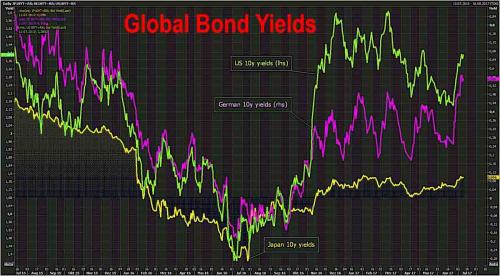U.S. index futures point slightly lower open. Asian shares rose while stocks in Europe fell as energy producers got caught in a downdraft in oil prices and reversed an earlier gain after Goldman unexpectedly warned that WTI could slide below $40 absent “show and awe” from OPEC. The dollar rose, hitting a four-month high against the yen and bonds and top emerging market currencies were back under pressure on Tuesday, following last week’s hawkish rhetoric from central bankers.
Nonetheless, driven by expectations for solid earnings growth, MSCI’s 46-country All World share index was up for a third day running, although it started to slip as Europe’s bourses lost their footing early on. According to Bloomberg, the early European focus was on the overnight rally in USD/JPY toward 114.50 after tripping stops through 114.37 high from May; strong 5Y JGB auction also supports as curve steepens. The USD held small gains against G-10 through the European morning, GBP/USD pushes higher through 1.29 in thin liquidity; EMFX underperforms markedly. USTs sell off in tandem with the move in USD/JPY and see further pressure after bund and gilt futures open. European equity markets open higher before reversing; FTSE 100 underperforms with retail sector lagging after Marks and Spencer (-3.8%) trading update. Auto sector rallies after latest China vehicle sales numbers.
Overnight, all eyes were on the BOJ, and whether it would intervene again as it did on Friday for longer-term debt maturities, to stem the ongoing rise in JGB yields following a five-year bond auction. However, Kuroda was spared intervention for the second time in one week after the five-year bond auction saw a jump in buyside demand in the form of the highest bid-to-cover ratio since August 2014. Still, the Japanese currency dropped to 114.48 per dollar, its weakest level since mid-March. According to the Deutsche Bank Trade Weighted Index, the yen stands at its lowest since February 2016, a reflection of Japan’s monetary policy divergence versus other major central banks, according to traders in Europe. According to Bloomberg, while the yen’s haven status keeps it in vogue in the longer-term, as shown by risk reversals, the fact that the BOJ looks behind the curve compared to other major central banks in normalizing policy is sending the currency into defensive mode.
Also overnight, China’s central bank resumed its open-market operations for the first time in 13 days, ending the longest pause since April, offering 40 billion yuan in reverse repos. The net effect on the financial system was neutral, as the amount of injections matched maturities for the day. The PBOC hasn’t added cash on a net basis for 16 days in a row. The weighted average 7- day repo rate climbed 8 basis points to 2.80% as of 5:30 p.m. in Shanghai; the overnight cost rises 9 basis points to 2.62%. Japan’s Topix Index climbed 0.7 percent. Hong Kong’s Hang Seng Index strengthened 1.6 percent, heading for its first back-to-back gain in three weeks. The Hang Seng China Enterprises Index soared 2.1 percent, its biggest advance since March 16. The Shanghai Composite Index was down 0.3 percent after a short-lived advance mid-afternoon local time. Other indexes on the mainland were also lower.
Meanwhile, the bond selloff continued with bunds opening lower following Treasuries, as Germany’s 10-year yield edged up 2 basis points to 0.56% having more than doubled over the last few weeks, with losses extending as gilts slumped before the 2056 I/L syndication; bonds touched day’s low as bidding opened on the Netherlands 30y sale, before paring losses after the sale. Bund futures dipped to day’s low of 160.48 (46 ticks) as bidding opened on the Netherlands 01/2047. Long-end French bonds outperformed core, with OAT/bund spread tighter by 1-1.5bps across the curve. The outperforming 15-20y sector has previously been highlighted as the preferred spot for domestic real money investors.

Roger Webb, Head of European Credit at Aberdeen Asset Management said the slightly stronger-than-expected global growth numbers had boosted expectations of higher interest rates.
“I think the increased hawkishness we have seen from the central banks has led to a fear that we could see a mini-taper tantrum. I don’t think there is too much alarm. I think the move to slightly higher yields in Europe and the U.S., UK and elsewhere is probably understandable.”
The shift in sentiment was enough to propel the dollar higher against the basket of currencies including hitting a four-month high of 114.43 yen on the back of the past fortnight’s 25 basis-point rise in 10-year U.S. government bond yields. The pound added 0.3 percent to $1.2917 while the euro traded little changed. The New Zealand dollar fell to its lowest since June 23 meanwhile after an earthquake hit the country’s South Island. The Canadian dollar was down slightly too against its U.S. counterpart as investors awaited a Bank of Canada interest rate decision on Wednesday. The South African rand, Turkish lira and Russia rouble all dropped around 0.8 percent as the emerging market selling resumed too.
In commodities, crude oil slipped back after pushing higher overnight in Asia. Increased drilling activity in the United States and uncertainty over Libyan and Nigerian production cuts clouded the future supply outlook, leaving U.S. crude down a third of a dollar at $44.13 a barrel and Brent at $46.57. A bearish Goldman note did not help.Spot gold edged lower too, dipping to $1,212.13 an ounce and back near a four-month low touched in the previous session. Spring wheat rose 1.6 percent to $8.1250 a bushel on the Minneapolis Grain Exchange, surging 51% this year amid concerns drought in U.S. Northern Plains will curb output to a 15-year low.

